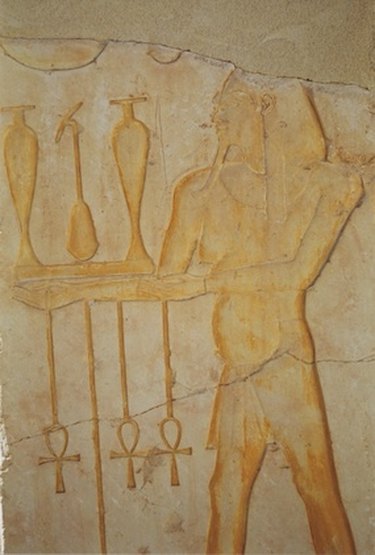
Ancient Egypt's existence spanned a long period of time, roughly from 3000 BC to 500 BC. The art produced by the culture varies slightly from period to period, but only to the expert eye. The majority of ancient Egyptian art uses the same techniques and styles across that 2,500-year span. Ancestor worship and a focus on record-keeping meant Egyptian artists ritualized techniques, specifically creating pieces that look similar to ones made years before.
Clarity
Video of the Day
Ancient Egyptians often combined artistic images with hieroglyphic writings, which means the result needed to remain clear to get its point across. Whether paintings or statues, the pieces always have clearly defined shapes. Paintings leave room between outlined images to keep each one in focus and statues have sharp ridges to make each accent stand out. Even hieroglyphics were composed with a thin line separating each horizontal row, which makes reading the "picture words" easier.
Video of the Day
Balance
Egyptians were also expert mathematicians, and this understanding of fundamental balance is reflected in the composition of their art. A tomb with a perfect stone obelisk positioned between two giant pharaoh statues is a perfect example of this balanced view. The exact lines of the pyramids, the visual balance in wall paintings and even the creation of symmetrical jewelry items displays this focus on basic balance.
Color
Color plays a huge role in ancient Egyptian art. The plain stone columns and statues we see in Egypt today have had the color worn away, but bright paints covered the stone in ancient times. Vibrant paints were used to decorate hieroglyphics, outline carvings and paint pictures. Bright materials were favored for jewelry and even the pyramids were once coated in a gold hue. Think of the rich blues, yellows, browns and reds present in the Nile landscape of Ancient Egypt. It's these same hues you see echoed in the art, such as in the bust of Nefertiti or Mask of Tutankhamun.
Perspective
While most ancient Egyptian paintings contain flat shapes, there is always a sense of perspective in the creations. A painting of a pharaoh on a throne has the pharaoh and throne in proper relative size to each other. Workers lining up to offer food to the king are also all relative in size to each other, although they may be smaller than the pharaoh. The one notable exception to the rule has to do with adults vs. children. Artistic depictions of royal children were often just miniature adult figures instead of true adolescent forms. So a queen holding her baby showed a queen with a very small adult on her lap.